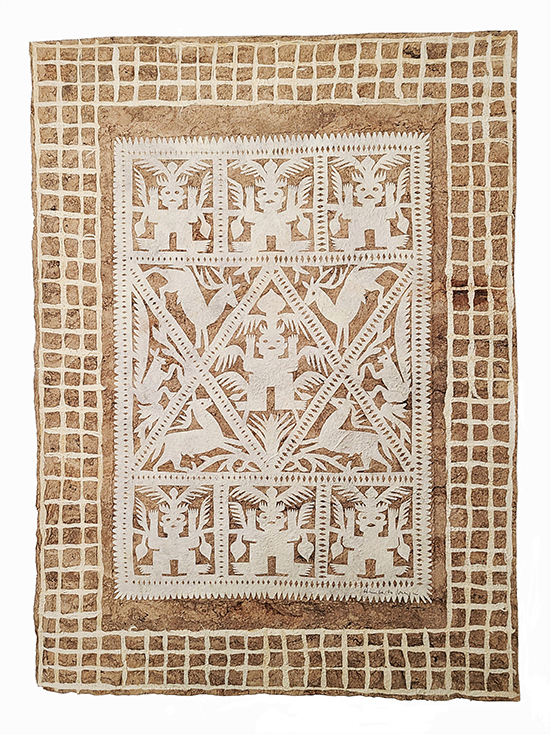Otomí Bark Paper

People in Mexico have made bark paper known as papel amate for almost 2000 years. Many Mesoamerican indigenous groups including the Toltec, Aztec, and Mixtec used it for a variety of purposes. While the practice disappeared across much of Mexico after the Spanish conquest when it was banned, the Otomí, an indigenous group in central Mexico, preserved the tradition. The Otomí village of San Pablito, high in the mountains in the northern part of the state of Pueblo, has been the center of bark paper making for hundreds of years.
The process of making papel amate has changed little over that time. Cuttings of bark are taken from trees in strips. The inner bark is separated and boiled in water with lime and ash to soften the pulp and is then rinsed. The pulp strips are laid out on a board in a grid and hammered with a flat stone until the strips merge to create a solid sheet of paper. Pieces like this one are made of two separate pieces of paper with two different thicknesses: a thicker piece for the bottom and a more delicate piece for the cutout design. The thinner paper is made first so it can be dried and cut before being applied to the heavier paper. The mirror image cuts are made by folding the paper. The two papers are then pressed together while the bottom piece is still wet.
This paper is made from the bark of the Jonote tree; however, many different types of bark have been used over time. Originally amate trees (wild fig) were used to make bark paper because they regenerate their bark when it is harvested in moderation. This is the source of the name papel amate. In part due to overharvesting, the people of San Pablito have shifted to using other types of trees.
Traditionally, Otomí shamans cut papel amate into dolls or muñecos that represent spirit beings. Figures cut from white paper represent good spirits, while figures cut from dark paper represent evil spirits. The dolls are used in rituals for many purposes including assuring a good harvest, rainmaking, banishing evil spirits, and curing illnesses. Beginning in the 1960s, the production of bark paper became highly commercialized through its sale in tourist markets. This commercialization did not contradict its spiritual use however, because the paper is not viewed as sacred unless it is cut by a shaman as part of a ritual.
This papel amate was made by Humberto Trejo Gonzalez, who is part of a family that has gained recognition for their combination of delicate and imaginative cuttings. The center figure, which is also repeated at the top and bottom is a papaya god. The piece represents a petition for a good harvest. In this example, the god figure is holding the papaya and roots grow from the figure’s feet to show a connection to the harvest. Other crops commonly represented in papel amate are peanuts, coffee, pineapple, mango and chili peppers.
Other Indigenous objects from Mexico that have been featured for Artifact of the Month include a Huichol votive bowl, a Chupícuaro tripod bowl, and a Remojadas bat whistle.
